The "New Synagogue"
The Haskalah Movement
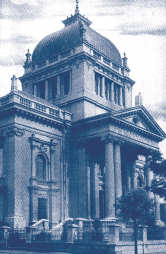 The Haskalah (“Enlightenment”) mov
The Haskalah (“Enlightenment”) mov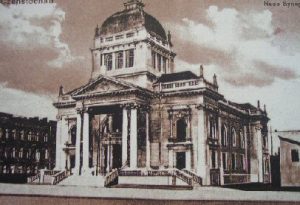 ement had its origins in Germany in the mid-18th Century. It had, at its core, an emphasis on Western culture, use of Hebrew instead of Yiddish, a love of Israel, and it encouraged the study of secular subjects. It is also credited with laying the groundwork for the eventual Zionist movement.
ement had its origins in Germany in the mid-18th Century. It had, at its core, an emphasis on Western culture, use of Hebrew instead of Yiddish, a love of Israel, and it encouraged the study of secular subjects. It is also credited with laying the groundwork for the eventual Zionist movement.
The Jews who came from nearby Germany in the late 18th and early 19th centuries and settled in and around Częstochowa, including the founders of the kehillah, brought with them the spirit of the Haskalah. In the late 19th Century, the more affluent of Częstochowa’s Jews moved away from the traditional Jewish quarter to the city’s centre, around I Aleja Najświętszej Marii Panny.
It is in this area, in 1893, that they built the New Synagogue, on the corner of ul. Wilsona (formerly ul. Aleksandrowska) and ul. Garibaldiego.
Due to its style of architecture, the presence of a male-voice choir, the dress of its clergy, the more modern pronunciation of the Hebrew prayers and its Haskalah philosophy, the New Synagogue came to be known within Częstochowa’s Jewish community as the Deutscher Shule (“German Synagogue”).
The Height of Chazanut
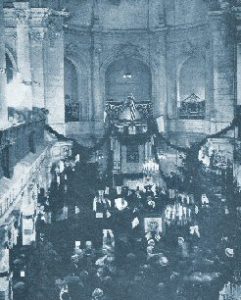 In accordance with the ideas of the Haskalah or Jewish Enlightenment, the New Synagogue sought to combine secular knowledge with religion. They chose outstanding scientists and scholars to be religious leaders,such as the historian Mayer Balaban.
In accordance with the ideas of the Haskalah or Jewish Enlightenment, the New Synagogue sought to combine secular knowledge with religion. They chose outstanding scientists and scholars to be religious leaders,such as the historian Mayer Balaban.
In 1903, as its first Chazan (Cantor), the New Synagogue apppointed Reb Abraham Birnbaum – a great coup as Cantor Birnbaum already had a great reputation throughout Europe for his Chazanut.
During his tenure, which ended in 1923, Cantor Birnbaum established a renowned cantorial school at the New Synagogue. Its graduates found success and admiration in the United States. He was also the first person to start a Union of Cantors. In his compositions. Cantor Birnbaum combined traditional Jewish themes with the elements of contemporary European music.
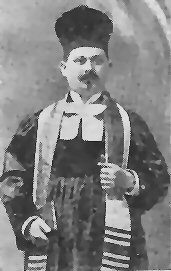
In 1923, Reb Avraham Fiszel (pic right) became the New Synagogue‘s Chazan. He lived with his family in an apartment on the synagogue premises.
In addition to his duties as Chazan, Reb Fiszel taught music at the Jewish high school and was instrumental in the formation of numerous Jewish choirs in Częstochowa.
After the Nazis set fire to the New Synagogue, Reb Fiszel decided to remain, living in a small shack in the synagogue courtyard, where he continued to perform his duties as best he could.
According to some historians, Reb Fiszel perished in Treblinka in 1942. However, other accounts tell the story of how, when he was caught conducting services by the Nazis, he was made to run through the streets in front of a Nazi motorcycle. When he was exhausted and could run no further, he was stood up against a wall and was shot.
Destroyed by the Nazis
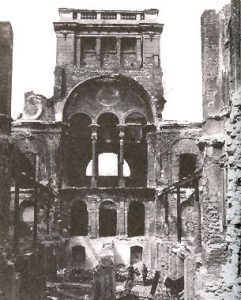
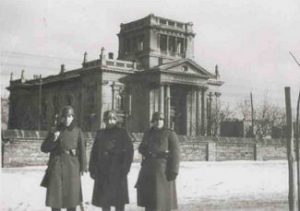 On Christmas Day, 25th December 1939, the New Synagogue was set on fire by German military policemen, assisted by their Volksdeutsch henchman.
On Christmas Day, 25th December 1939, the New Synagogue was set on fire by German military policemen, assisted by their Volksdeutsch henchman.
The Judaic library, with its rich music collection, was decimated along with the building itself.
After the Nazis had left, it has been reported that Reb Fiszel, together with three others (Gliksman, Mitz and Dawidowicz) entered the synagogue ruins and saved whatever they could.
It is quite possible, that the New Synagogue‘s Aron Ha’Kodesh, which has been held in the Jewish Historical Institute’s Warsaw warehouse until this very day, is still in existence only due to the daring efforts of these four individuals.
Until his death (whether at Treblinka or in the streets of Częstochowa), Reb Fiszel continued to conduct services in the basement of the ruins of the New Synagogue.
Today …
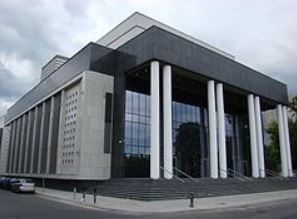 Sadly, Częstochowa’s New Synagogue only stood for 46 years, before its destruction by the Nazis.
Sadly, Częstochowa’s New Synagogue only stood for 46 years, before its destruction by the Nazis.
Today, on the corner of ul. Wilsona and ul. Garibaldiego, where the New Synagogue once proudly stood as a symbol of Częstochowa Jewry, stands the Bronisław Huberman Częstochowa Philharmonic Concert Hall, home of the Częstochowa Philharmonic Orchestra.
Given this site’s historical significance to the Jews of Częstochowa, it is more than fitting that this building has been named after world-famous violinist Bronisław Huberman, a Częstochowa Jew and founder of the Palestine Symphony Orchestra (comprised of Holocaust escapees) and which today is known as the Israel Philharmonic Orchestra. This building hasalso been the focal point for many of the activities which have takenplace during our Reunions in Częstochowa.
While the New Synagogue stands no more, it is a little melancholic that, even today, when performances of various kinds are advertised for this venue, occasionally the venue is still referred to as The Synagogue.
